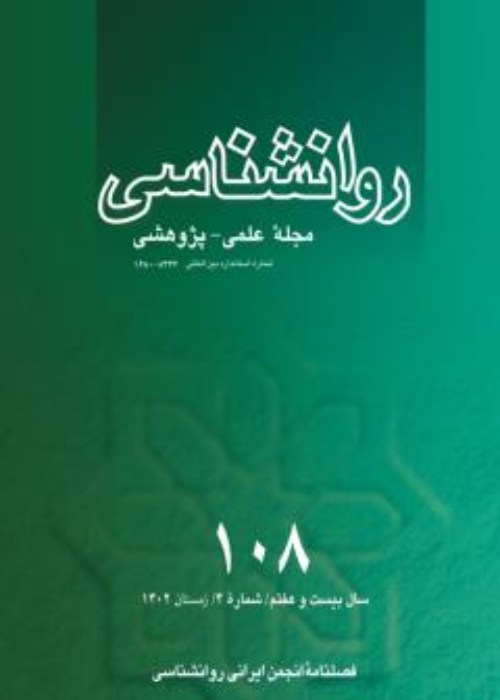فهرست مطالب

فصلنامه روانشناسی
سال دوازدهم شماره 1 (پیاپی 45، بهار 1387)
- 120 صفحه،
- تاریخ انتشار: 1387/03/20
- تعداد عناوین: 9
-
-
سخن سردبیرصفحه 2
-
خبرصفحه 119
-
Page 4The purpose of t his study was to determine the relationship between happiness, dogmat ism-flexib ility and demographic variables in Isfahan population. Therefore, in the format of a correlation research design, 80 male and 80 female subjects were selected from Isfahan city, using cluster random sampling. All subjects responded to the items of the Oxford Happ iness Inventory the, Dogmatism Scale (a=0.70) and a demographic questionnaire. Data were analyzed by Pearson’s correlation coefficient, regression and covariate. It was hypothesized that there would be significant relations between all the variables. The results showed that there was a significant positive correlation between happiness and flexib ility (p < 0.01). There was also a 5significant negativ ecorrelation betweenhappiness and familysize (p< 0.01). Further, the results revealed that family size significantly predicted 8.4% of happ iness, (p< 0.01). Therefore, it was concluded that the more flexibility increases and the more family size decreases, the more happ iness increases.Keywords: happiness, dogmat ismflexibility, demographic variables
-
Page 20The roleo fme t a cogn it io n in d evelopme nt a nd ma in t e n an ce o f o bsess ive-comp u lsive d iso rd e r an d post-traumatic stress disorder has gained p romin ence through t he info rmat ion processing model advanced by Wells and Mathews. The aim of the present research was to compare the metacognitive beliefs and dimentions ofperfectionism of the patients with obsessive-compulsive d isorder and post-traumatic stress disorder in intraction with uncertainty. The sample consisted of 127 subjects in three groups: Those who were diagnosed as obsessive-compulsive disorder (43 subjects) and post-traumat ic stress d isord er (43 subjects) selected from psychiatric clinics in Tehran city, and a non-p at ient group (41 subjects). The participants completed the short form of the Me t a co gn it io n Qu e st io n n ia r e, t h e PerfectionismofMultidimentions Scale and 2the Intolerance of Uncertainly Scale. Results showed that the patients with obsessivecompulsive disorder had higher levels of dysfunctionalmetacognitive beliefs than the patients with post-traumatic stress disorder and the non-patient subjects. Also, the results showed that the patients with obsessivecompulsive disorder and those with posttraumatic stress disorder had higher levels of dimentions of perfectionism than the nonpatient subjects. Group and uncertainty intraction was significant for perfectionism (p< 0.10), but it was not sign ificant for metacognitive beliefs.Keywords: met acogn it ive b eliefs_p erfect ion ism_unce rta inty_obsessivecompulsive disorder_post_traumatic stress disorder
-
Page 36The aim of this research was to study the effects of behavioral cognitive therapy and cognitive therapywith religious orientations on depression and T lymphocyts response to PHA in mitogen. 60 depressive patients were selected and randomly divided in 60 two groups (30 patients in each group). Two groups were matched for age, education, sex and economical status. For the first group, behavioral cognitive therapy was used for 12 sessions. For t he second group, both behavioral cognitive therapy and religious strat egies were app lied. The rate of depression and T lymphocyts’ response to PHA in mitogen were assessed in three stages: Before and after the intervention and after six months as the follow- up period. The results revealed that there was a significant difference between the rate of depression and T lymp hocyts response to PHA in mitogen before and after the final sessions of therapy and also after the follow upperiod. The results also indicated that although the rate of depression decreased in the two groups, while the T lymphocyts response to PHA increased, but, the effects of religious strategies on depression lymphocyts response to PHA were significantly better than those of behavioral cognitive therapy. Fortherwere, it was found that religious strategies had significant effects on the hyperactivity of T cells to PHA mitogen stimulation, i.e. they reduce the rate of depression.Keywords: depression, b ehavio ral cognitive psychotherapy, religiousstrategies, T lymphocytes, PHA
-
Page 50Chronicpain is a mult idimensional phenomenon uniquely experienced by each patient.Within this perspective ofpain, the knowledge regarding a patient’s appraisals of his/her experience of pain and the impact of pain on daily activities become critical for accurate evaluation of treatment outcome. The West-Haven Mult idimensional Pa in Inventory (MPI) has been developed to measure the patients’ perspective about their pain experience. This study examined the reliability and validity of a Farsi translation of the two first sections of the MPI, MPI-F on a population of 231 subjects with chronic pain. The results indicated that 7 out of the 8 subscales of the MPI-F had satisfactory reliability; the Cronbach’s alphas for these subscales ranged from 0.77 to 0.92. The meaninter-itemcorrelation providessupport for the internal consistency of all the 8 subscales. Convergent valid ity of the 8 subscales of the MPI-F was confirmed, using the correlat ion of e ach it em wit h its hypothesised scale. Discriminant validity of the 8 subscales of the MPI-F was shown, u s in g c omp a r iso n s b e t we e n t h e intercorrelations of the 8 subscales of the MPI-F with the reliab ility coefficients (Cronbach alph) of the 8 subscales. The 8 subscales of the MPI-F were then correlated with pain intensity, depression and mental and physical components ofQuality of Life Scale, as measured by the Short Form Health Survey Questionnaire (SF-36). The results of these analyses confirmed the criterion validity of the 5 subscales of the MPI-F.While higher scores on p a in intensity, interference, affective distress and negative response from sign ificant others were sign ificantaly associated with more severe p ain, more depression and poorer quality of life. Higher scores on life control were significantly associated wit h lower levels of p a in, dep ression and b ett er quality of life. Furthermore, the significant associations between the two MPI-F subscales of pain intensity and affective d istress with p ain intensity and depression measures provided support for the construct validity of these two MPI-F subscales. The present study did not establish criterion validity for the three subscales of t he MPI-F. The clin ical implications of these findings are discussed.Keywords: chronic pain, Multidimensional Pain Inventory, psychometric properties
-
Page 72The aim of the p resent study was to investigate the predictive role of family context in the adolescents personal profile including positive adjustment to high school, goal orientation, concern about preparation for the future, and general confidence. A sample consisted of 341 female and male students from the first grade of high schools in Shiraz were selected using random cluster sampling. Subjects answered the Family Context and Personal Profile Scale. The Cronbach’s coefficient alpha and test-retest reliability were computed and the obtained coefficients ranged from 0.49 to 0.88. Results showed a significant positive relationship between authoritative context and personal p rofile, adjustment to high school, goal orientation, concern about preparation for the future, and general confidence. For close families, the results were the same as those of aut ho ritat ive families. There was no significant relationship between the three other contexts and the dependent variables. St epwise mult ip le regression an alysis revealed that close families context was p red ictive of personal p rofile (b=.13), general confidence (b=.32), adjustment to high school (b=.28), and goal orientation (b=.38). Also, authoritative family context could predict personal profile (b=.26) and adjustment to high school (b=.26).Keywords: family context, general confidence, personal profile, adolescents
-
Page 89This research consisted of 101 female B. A. athlete students and 101 female B.A. non-athlete students in Tarbiat Moallem University (Tehran, Iran). The instruments included Averill Emot ional Creat ivity Inventory, the Endler and Parker Cop ing Inventory for Stressful Situation and the Goldberg General Health Questionnaire (GHQ). Results showed that the mean scores ofmental health, emotional creativity, task oriented cop ing, and avoidances-oriented cop ing of the female athlete students were sign ificantly difference from the female non-athlete students. Howevere there was no significant difference between the athlete and non-athlete students in their emot ional oriented coping. The only predictor variable concern ing the ment al health in the non-athlete students was the avoidanceoriented cop ing. In the athlete students, although, avoidance-oriented coping was a predictor variable on mental health in the first step but in the second step, t he avoidance-oriented cop ing and emotional oriented coping were significant predictors of mental health. The emotional creativity of the non-athlete and athlete students was not significant predictor of their mental health.Keywords: cop ing styles with stress, task, oriented cop ing, avoidance, oriented coping, emotional creativity, general health, regulated behavior exercise, aerobics
-
Page 104Cigarette smoking, so current among the youngsters and adolescents, is the greatest enemy of public health. This syudy aims to determine the smoking pattern of the high school students in Isfahan and its relationship with parenting style of their mothers. 351 students were selected using cross sectional method. Students answered to a questionnaire, in which the smoking pattern (non smoker, occasional smoker, monthly, weekly and daily smoker) and parenting style (authoritative, authoritarian, permissive and rejecting) were evaluated. Data were analyzed by SPSS program. Results indicated that 10.3% of the students were currently smoking and 37.9% of them had experienced smoking at least for one t ime. The age of students had no significant relationship with smokingpattern but the employment status of students and having smoker friends had sign ificant relat ionships with smok ing. Cigarette smoking and having smoker friends in the students who had mothers with authoritative style were sign ificantly lower than the students with rejecting parenting style. Parenting style and having smoker friends were significant predictors for smoking and the students who have authoritative mothers had selected their friends from nonsmokers.Keywords: parenting style, mother, cigarette smoking, high school students


